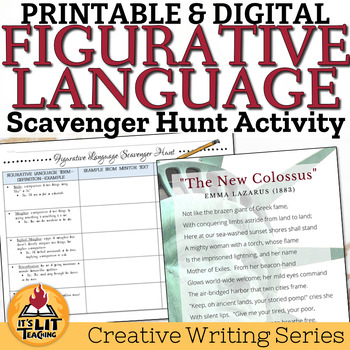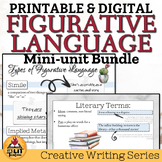Figurative Language Scavenger Hunt Activity | Printable & Digital
- Google Drive™ folder

What educators are saying
Also included in
- Teaching figurative language as part of a poetry unit or Creative Writing class? Want to review figurative language techniques without the boring worksheets or sit-and-get lessons? This bundle of 5 figurative language resources will not only teach your students figurative language terms but engage tPrice $10.38Original Price $12.97Save $2.59
- Take the stress out of planning a high school Creative Writing class with this complete, 9-week elective course curriculum bundle! This Complete Creative Writing Class Bundle includes everything you need to teach creative writing skills, poetry analysis, and engage students in a variety of writing aPrice $76.70Original Price $96.37Save $19.67
Description
Engage students in learning all about figurative language techniques with this PRINTABLE AND DIGITAL Figurative Language Introduction Slideshow and Scavenger Hunt Activity! This activity uses movement around the classroom and mentor texts to make learning about figurative language more engaging than a sit-and-get lesson.
This lesson begins with a short introduction slideshow covering ten types of figurative language.
Then, students will complete a scavenger hunt by walking around the room to find an example of each type of figurative language. They will need to find the example amongst five poetry posters, which will have been hung prior to class.
After the scavenger hunt, students must create their own examples for each example of figurative language.
If you find yourself teaching remotely or using a hybrid model, instead of hosting a scavenger hunt around the room, simply assign the included digital version instead! Students will still have to hunt down examples through five poems in a slideshow and record their findings.
This Figurative Language Introduction Slideshow and Scavenger Hunt Activity covers the following terms:
- Simile
- Metaphor
- Implied Metaphor
- Personification
- Hyperbole
- Allusion
- Idiom
- Pun
- Onomatopeia
- Alliteration
These terms were chosen based on this article from MasterClass.
This NON-EDITABLE resource includes:
- Lesson Plan (PDF)
- Introductory Presentation (non-editable Google Slides)
- 5 mentor text posters (18" x 24" PDF)
- Student Worksheet (PDF)
- Digital Version (this includes the five posters and student worksheet in a Google Slides document)
- Example of Possible Answers (PDF)
Need more figurative language lessons? Get the BUNDLE or check out my other resources:
- Figurative Language Student Handout
- Figurative Language Task Cards
- Figurative Language Tasting Activity FREEBIE
- Figurative Language Photo Description Activity
***This resource consists of editable and non-editable PDFs and Google files within a Google Folder. In order to access your purchase, you will need to give Teachers Pay Teachers access to your Google Drive. Before purchasing, please review the preview to make sure this resource supports your and your students' needs.







